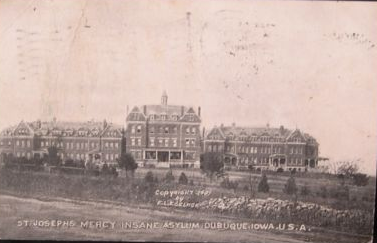Encyclopedia Dubuque
"Encyclopedia Dubuque is the online authority for all things Dubuque, written by the people who know the city best.”
Marshall Cohen—researcher and producer, CNN
Affiliated with the Local History Network of the State Historical Society of Iowa, and the Iowa Museum Association.
ST. JOSEPH'S INSANE ASYLUM
ST. JOSEPH'S INSANE ASYLUM. A medical facility established by the SISTERS OF MERCY, the asylum was located on Asbury Road near the intersection of Hillcrest Road. The institution was originally known as the Insane Asylum of West Dubuque. This name was changed to ST. JOSEPH'S SANITARIUM in November 1909. The building replaced an earlier facility in the city which had been found to be undesirable and currently handling eighty-four patients. (1)
Work on the building was to begin in the spring of 1895. Costs estimates ranged from $65,000 to $75,000 for the facility which was built to care for 210 patients. (2)
Facing east, the building was 324 feet long. The administration portion separated the men's wing on the north and the women's wing on the south. The administrative section had its greatest length from east to west while the two wings had their greatest length from north to south. The main building was heated with steam and had electric lighting. A three-story building to the west housed the boiler and engine room with two floors of dormitories for the hired help. (3)
In the basement of the administration portion were two dining rooms, male and female, for private patients. Each dining room could handle twenty people. The basement also included two wards, sitting rooms, and work rooms for private patients, kitchen, cellar, bakery, cold storage, sewing rooms, dining rooms for Sisters, and toilets. There were three padded cells for violent patients. On each side was a public ward containing a dining room for seventy-four and toilets. (4)
The first floor in the administration section included reception rooms, office, suite of rooms for the chaplain, office, dormitory and dispensary for the physician, dining room and dormitories for Sisters, toilets, a chapel that would seat two hundred people, and a tea kitchen. On each side was an infirmary for sick and epileptic patients. Each infirmary ward had a day room and in back of it ten bedrooms, store rooms, two private dormitories, hall and toilets. (5)
The second and third floors were identical. The administration section was devoted to bedrooms and balconies. The second floor was for chronic and work patients. The first floor would accommodate 33 in each ward, the second would accommodate 36, and the third would accommodate 36. (6)
In April, 1967 forty-five acute psychiatric patients were transferred by bus to the new Mental Health Department, once a convent, at MERCY HOSPITAL. An estimated 34 others had been transferred to other institutions in Iowa. The transfer was part of the plan to merge Mercy Hospital, St. Joseph's Santarium, and ST. ANTHONY'S HOME FOR THE AGED into a single complex to be renamed MERCY MEDICAL CENTER in July. The transfer also enabled patients to received Medicare and Blue Cross benefits. Prior to the move, patients only received 75% of Blue Cross Benefits because the sanitarium was not a Blue Cross member. The facility had also failed to meet requirements for Medicare. (7)
The relocated patients were cared for in the renovated convent area until a $7.5 million addition was readied. The sanitarium was put up for sale since it could not be used as a health facility unless it was rebuilt. (8)
Land upon which the facility had been located was later the site of the Red Cross Blood Center.
---
Source:
1. "A New Asylum," Dubuque Daily Herald, February 22, 1895, p. 5. Online: https://news.google.com/newspapers?nid=_OG5zn83XeQC&dat=18950222&printsec=frontpage&hl=en
2. Ibid.
3. Ibid.
4. Ibid.
5. Ibid.
6. Ibid.
7. " 'San' Closing After 85 Years," Telegraph Herald, April 27, 1967, p. 1
8. Ibid.


